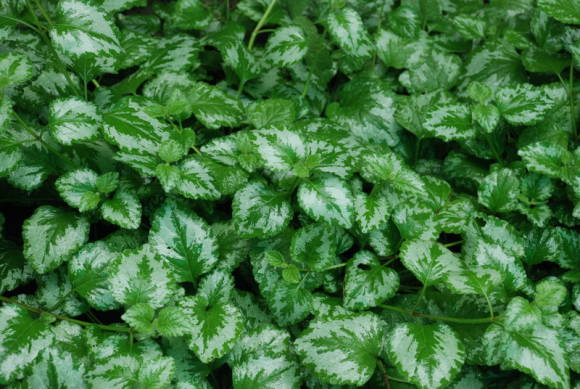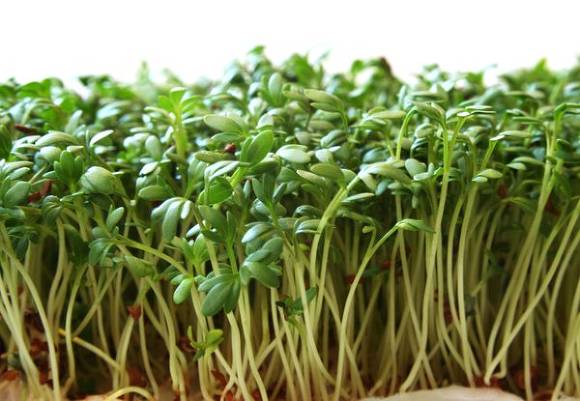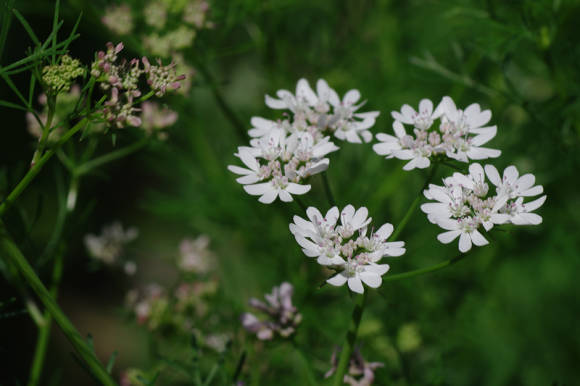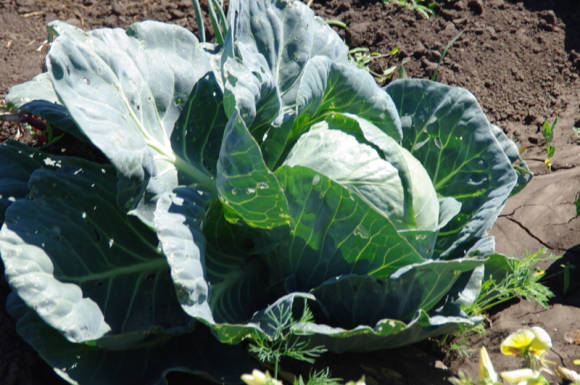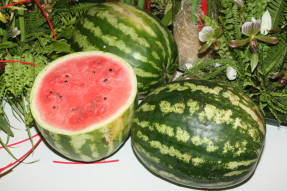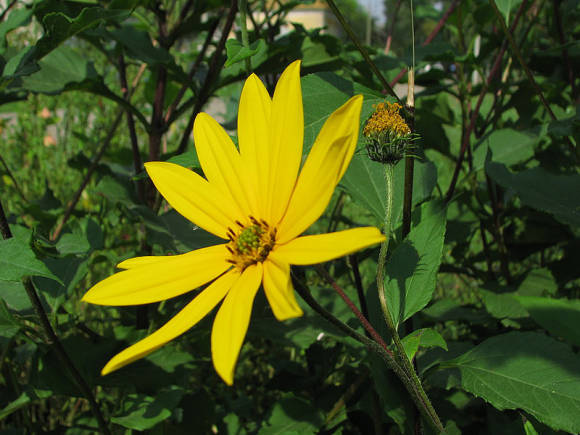Canna garden (Canna x hybrida hort.) - perennial herb (family Cannaceae Juss, order Zingiberales Nakai) with a straight false stem 0.5-2.5 m high, underground sympodial rhizome, alternate large broad-oval leaves (from bluish-green to violet-red). Canna, thanks to its large crimson, red, orange, salmon, yellow flowers, collected in a curl inflorescence, is often used in the design of parks, gardens, squares. The flower is three-membered and consists of five whorls: the first two form the perianth, the next two belong to the androecium, and the last to the gynoecium. The inner circle of the androeum is incomplete; it includes the staminode, which curls outward and the stamen-petal. The outer circle of the androeum is formed by three petaloid staminodes. The flowers are bisexual. Cannes are self-pollinating plants, but they can also be cross-pollinated (wind, insects). The fruit is a rounded or oblong three-chambered prickly capsule from pale green to violet-red color. Mature seeds are oval, large, very hard, dark brown or almost black [1, 4].
There are 3 main groups of cannes.
- Cannes Crozi - undersized plants (0.5-1.2 m). Gladiolus-shaped flowers, about 10 cm high, staminodes with bent edges ('Gift of the East', 'Livadia', 'President', 'Chameleon', 'A. Wendhausen', 'Masterpiece', 'Gift of Crimea', 'Sunset Reflection' ).
- Orchid group - tall plants (1.2–2 m). The flowers are large, in shape reminiscent of the Cattleya orchid, 13-15 cm long. Staminodes are corrugated along the edges (‘Suevia’, ‘Captain Yarosh’).
- Deciduous small-flowered cannes are tall plants (1.5–3 m). Flowers are small, 6 cm long, staminodes are narrow.
Species of the genus Canna L. come from tropical and subtropical regions of America and southeast Asia. Cannes began to be used in ornamental gardening in the second half of the 19th century, it was then that it first appeared in the parks of Paris. In ancient times, some of its species were grown as a source of starch (C. gigantea Red., C. flaccida Dill., C. coccinea Rosc., C. edulis Ker.), from which, among other things, glucose was obtained.
 |  |
Cannu edible (Canna edulis) to this day are cultivated in America, India, Indonesia, Korea, Australia and the Hawaiian Islands as a starchy plant (rhizomes contain 27% starch). K. edible is used in traditional Asian cuisine, in confectionery production, and also as a fodder crop. In folk medicine cannu east (Сanna orientalis) is used as a diaphoretic and diuretic, and edible - as a dietary product for gastrointestinal diseases [5]. The antidepressant effect of drugs from cannabis rhizomes is well known; they have traditionally been used in the rehabilitation of drug addicted people.
The name canna comes from the Greek word kanna (reed) due to the similarity in the structure of the stem. Latin kanna translates as a tube.
There is a legend that Kanna grew up on the site of a fire, into which one of the leaders of the warring Indian tribes threw a wampum with the terms of a peace treaty (wampum - a kind of subject writing), after which a bloody war began. The fiery red petals of canna still represent the flames today.
In 1815, the first canna plants were introduced in the Nikitsky Botanical Garden. Currently, the collection of Canna Sadovaya includes 26 varieties of the NBG selection and 23 foreign cultivars.
 |  |
Cannu is propagated by seeds and vegetatively. However, the seeds have a very hard shell, so they germinate for a long time and unevenly. To accelerate the emergence of seedlings, pre-sowing seed treatment is often carried out.
In our experiments, we used the following types of action on the seeds of the Dar Vostoka and Livadiya varieties (obtained from free pollination): immersed in a sulfuric acid solution for 60, 120 min, cold treatment (+ 5 ° C) was used for a day, then kept in boiling water for 10 seconds, cut the seed coat with a scalpel.
 |  |
In the course of the research it was revealed that the seeds of the ‘Livadia’ variety did not germinate both with the use of pre-sowing seed treatment and without it. At the same time, in the canna 'Dar Vostoka', the seeds of which were previously scarified with a scalpel, after 28 days the highest germination rate was observed - 46.2%.It should be noted that the seeds of this variety did not germinate after heat treatment.
The existing cannes varieties are the result of numerous interspecific and interspecific crosses. In the first generation, their seed offspring are heterozygous, and in subsequent generations, splitting of traits occurs. To consolidate the positive properties obtained as a result of crosses, cannes are propagated vegetatively [1]. To do this, in late March - early April, the rhizomes are divided into parts, each of which should contain two well-developed renewal buds. The first inflorescences appear after 1.5 months, the plants bloom profusely until the first frost. The multiplication factor using traditional methods is 3–8.
 |
Leaves and inflorescences of valuable canna varieties are often affected by fungal, bacterial and especially viral diseases. In recent years, a wide spread of viral infections in the garden canna was noted in Europe, the CIS, South and North America, which causes a deterioration in the physiological state of plants and a loss of decorative qualities. In this regard, scientists are actively developing modern methods of accelerated reproduction, including the mandatory diagnosis of viral diseases.
So, in the Nikitsky Botanical Garden, researchers of the Laboratory of Plant Biotechnology and Virology have been studying viruses of garden crops for more than 20 years and developing methods for improving planting material. In conditions in vitro virus-free plants of various varieties of anthurium, begonia, hyacinth, hippeastrum, lily, tulip, caladium, cymbidium, chrysanthemum, carnation, gerbera, etc. were obtained.
At the same time, in 2011, Doctor of Biological Sciences. O.V. Mitrofanova and her colleagues examined the collection areas of the Garden to identify the phytopathogens of the canna, clematis, and rose and to assess their distribution. As a result of a survey on canna plants, they noted a number of symptoms of a viral infection, such as yellow and chlorotic spot, streakiness, chlorosis along the veins and along the edge of the leaf, variegation. Moreover, in some varieties, 3 causative agents of viral diseases were detected simultaneously [2].
When developing a health improvement system in vitro and clonal micropropagation of plants, a complex of methods was used, including chemotherapy and culture of organs and tissues. The research was carried out on promising varieties of canna Sadovaya from the collection of the Nikitsky Botanical Garden: 2 varieties of NBS selection (Dar Vostoka, Livadia) and 2 foreign cultivars (President, Suevia).
After surface sterilization, primary explants (vegetative buds) were placed in tubes with specially selected nutrient media containing macro- and microelements, vitamins, growth regulators, sucrose, and agar-agar. For chemotherapy, virocides, substances that suppress the development of a viral infection in a plant, were added to the nutrient media. After 30-60 days of cultivation, vegetative buds began to form adventive shoots (plant organs originating not from the embryonic tissues of the growing point, but from older parts of the plant and developing in unusual places, for example, buds on roots, leaves, stem internodes), which were separated and transplanted onto a freshly prepared nutrient medium [3]. With long-term cultivation in vitro a large number of meristemoids were formed at the base of the explants. Subsequently, micro-shoots developed from them, which were transferred to the medium for rhizogenesis and rooted. The resulting regenerant plants with 3–4 leaves and 5–6 roots were planted for adaptation into a sterile soil substrate.
 |  |
| The emergence of adventive shoots in the basal part of microshoots | Plant-regenerant variety 'Dar Vostoka', suitable for disembarkation in a sterile soil substrate |
As a result of the studies, the following was revealed. Cannu garden can be successfully propagated by the method of organ and tissue culture in vitro in combination with chemotherapy. it
allows you to improve the health of plants and obtain planting material in a much larger (100-1000 times) quantity and in a shorter time than when using traditional methods of propagation; helps to save time and reduce losses during the rooting phase of plants.
 |
Literature.
1. Dashkeev E.A. Cannes in Moldova. - Chisinau: Shtiintsa. - 1975 .-- 65 p.
2. Mitrofanova IV, Mitrofanova OV, Ezhov VN, Lesnikova-Sedoshenko NP, Basket NV, Ivanova IV. Identification of phytopathogens in landscape gardening agrocenoses and biotechnological ways of improving vegetatively propagated decorative and fruit crops // Introduction, conservation and use of biological diversity of the world flora: Proceedings of the International Conference dedicated to the 80th anniversary of the Central Botanical Garden of Belarus. Minsk, June 19-22, 2012. - Minsk, 2012. - Part 2. - P. 423-427.
3. Tevfik A.Sh. Regeneration of canna garden plants (Canna x hybrida hort.) In the culture of vegetative buds in vitro // Trudy Nikit. nerd. garden. - 2012. - T.134 - S. 426-435.
4. Feofilova G.F. Catalog of floral and ornamental plants in open ground from the collection of Nikitsky Botanical Gardens (Cannes) // Yalta, 1997. - 34 p.
5. Sholokhova TO, Biological characteristics and selection of garden canna: Author's abstract. dis.
Cand. biol. Sciences: 03.00.05 / Nikit. nerd. garden.— Yalta, 2001. - 19 p.
Photo by A. Tevfik
The magazine "Floriculture" № 6 - 2014
 Canna Garden Sunset Glow Canna Garden Sunset Glow
Canna Garden Sunset Glow Canna Garden Sunset Glow  Canna garden Gift of the Crimea Canna garden Gift of the Crimea
Canna garden Gift of the Crimea Canna garden Gift of the Crimea  Canna garden Livadia Canna garden Livadia
Canna garden Livadia Canna garden Livadia

